If you are serious about earning a living from YouTube, then you need to treat your channel like a business. Part of this approach is to diversify your revenue streams as you grow your channel. Being an Amazon affiliate could be one of those streams.
Traditionally, there are five revenue models for YouTubers – ads, sponsorship, patronage, directly selling something/merch, and affiliate marketing. Each has their pros and cons. However, most financially savvy creatives use some combination of all of them.
Affiliate sales can be incredibly lucrative for mid and late-stage channels. But it’s also one revenue model that can be used at the start. Your very first videos can include affiliate links. Having an understanding of how your channel converts, via affiliate marketing, can be incredibly important in negotiating your first sponsorship deals. It also provides a realistic baseline of your channel’s value at a given point in time.
As your channel grows, your affiliate revenue may ebb and flow but it should continue to be the foundation you build your financial empire.
Stay Focused on Your Goal at the Beginning
It’s also important to note that focus is important in the early stages while diversification is important in the long run. This is relevant in two ways:
1. From the multiple revenue stream perspective, we encourage you to start with affiliate marketing. But please note that it can be risky to have it be your sole revenue stream at a later stage.
2. But “focus” is also relevant inside the world of affiliate marketing as starting with laser focus is helpful. For this reason, we strongly recommend simply starting with the Amazon.com Associates program to learn the ropes, then expanding from there.
Learn how the affiliate model works – then it’s time to start scaling.
Don’t let yourself get sucked into creative, or complicated, programs and tools. In the early days, you want to do the bare minimum to build and add affiliate links so you can keep your energies focused on building your most important asset — an engaged audience.
How Affiliate Marketing works for YouTubers
In super simplified terms, affiliate marketing revolves around you, the YouTuber, recommending a product, either in the video or not. Then use specialized “affiliate” links to send your viewers to whatever it is that you are recommending so they can then purchase it.
These affiliate links include a tracking parameter that lets the retailer know when you referred a sale. The retailer, in this case, Amazon, will then reward you with a percentage of the products that were sold to the shopper you recommended.
Most YouTubers will include affiliate links in the descriptions of their videos for products that fall into one of two groups:
1. The specific product(s) or service(s) you recommended in your video. For example, an unboxing or gadget review video is the perfect candidate to include an affiliate link. The viewer to then go buy the product you were talking about.
2. Links to the products and services you use to create the video or regularly use and swear by. A common example here is to see the list of cameras, mics, and other gear used, with affiliate links to buy them (or even a link to the YouTuber’s “kit” of filmmaking gear).
Amazon Affiliate Marketing: An Overview
While the Amazon affiliate program, known as the “Associates Program,” isn’t perfect, it’s a great place to start and will grow with you. In fact, some of the biggest YouTubers still swear by it. Besides staying “focused” and starting with just one program, here are some of the things that make the Amazon.com affiliate program a great first step:
It’s Easy to Use
There are a handful of reasons why Amazon’s affiliate program is easy to use:
Because the Amazon affiliate program is “in house” there isn’t an additional layer of complexity to deal with like many other programs that use an “affiliate network.” This means that documentation and the “Associates Central” dashboard are focused on just the single affiliate program.

Building an Amazon affiliate link is incredibly simple. This means you can choose any product you want to recommend and quickly convert it into an affiliate link.
There are numerous tools, built and managed by both Amazon as well as third parties, that take a lot of work out of the Associate’s program.
As most of us are regular shoppers of Amazon we understand and feel comfortable with the store. As their affiliate program is just an extension of the store, it has some inherent familiarity and thus comfort for us.
Finally, the Amazon affiliate program is quite mature so almost everything has been vetted and fully tested meaning that as long as your affiliate links are built correctly, and you are following the rules, it’s really hard to mess up using the Amazon affiliate program.
Amazon Has a Huge Product Catalog
Amazon sells a lot of stuff! Some quick research shows that in 2016 Amazon had more than 12 million products directly for sale, not including books, media, wine, and services.
This means that nearly everyone has something they want that is available for sale on Amazon. This allows you to go deep into a niche without needing a specialty retailer.
Amazon Has a Huge Market Share
In the US, Amazon is estimated to have about 38% US eCommerce market share (source). Further, 95 million people have Amazon Prime memberships in the US (source).
You can interpret this as lots and lots of people online already trust and regularly choose Amazon to buy from, which makes it an easy decision of where to try and first start recommending products and capturing affiliate sales.
You Can Benefit From “Halo” commissions
Combining those last two items, market share, and product catalog unlock one of the biggest advantages and what makes Amazon Associates really unique — “halo commissions.” These are the commissions you earn on products you weren’t even recommending.
For example, you can earn commissions when someone buys toilet paper, even though they clicked on a link to the TV you were reviewing and recommending! These halo commissions can make up a significant chunk of the revenue you generate from the Amazon affiliate program.
Amazon Has International Coverage
Amazon has incredible brand recognition worldwide, which can be a big benefit for you as you build out the audience on your channel.
The Amazon.com storefront supports both English and Spanish and a large number of products can be shipped internationally. Amazon also has a number of regional storefronts that they’ve spent billions on optimizing for regional markets.
Compliance & Staying On Amazon’s Good Side
While we’ll cover the three most common mistakes, and provide links to additional resources, it’s important that you take the time to review the Amazon Associates Operating Agreement and the accompanying Program Policies. Further, it’s also important to note that we aren’t lawyers and this isn’t legal advice.
Just remember, you can’t win the game if you don’t know the rules!
Stay Away From Cloaking
This is a bit of a misnomer of a term but is often cited as the most common reason YouTubers are banned from the program.
First, it’s important to note Amazon absolutely allows you to use a link shortener, or a third-party tool, with your Amazon affiliate links. However, when doing so, it’s important that you disclose the destination of your link. This leads to two simple things you need to do to avoid Amazon’s wrath:
Mentioning Amazon – “Shopper Trust” is an important theme to Amazon and that relates to their affiliate program as well. When you post Amazon affiliate links in your video descriptions using a third-party tool it’s really important that you mention “Amazon” in near proximity to the link. It’s essential the shopper knows where they are going when they click on that link (it can also help with conversion rates by helping the shopper better trust the link).
List Your Channel – Remember that step when you were signing up for the Amazon affiliate program where you listed the various sites and social media channels you were planning on using your links? Well, have you kept that updated? If not, do it now (and be sure not to just put “youtube.com” but rather the full URL for your channel). There is a best practice, explored below, that simplifies this requirement.
Amazon Affiliate Marketing and Full Disclosure
Being transparent that you are promoting a product and that you can financially benefit is absolutely critical in the world of affiliate marketing, especially with the Amazon affiliate program. There are two “levels” at which you need to publicly state your usage of an affiliate program, Amazon’s or not.
FTC Disclaimer
The U.S. Federal Trade Commission (FTC), has the mandate to help the average (American) shopper know when they are being advertised to. In the eyes of the FTC, being “advertised” to includes using affiliate links when you recommend products. As a result, to be in compliance with the FTC’s rules you need to make your affiliate disclosure “clear” and “conspicuous.” A few examples include:
“I may earn commissions for purchases made through the links below.”
“If you buy something through our “links” we may get a small share of the sale.”
“Please know, Amazon may collect a share of sales or other compensation from the links below.”
Amazon Associates Disclaimer
In addition to the FTC disclaimer, the Amazon Affiliate program also requires you to include a notice about your relationship with Amazon. This is a standardized disclosure and simply reads: “As an Amazon Associate I earn from qualifying purchases.”
Unlike the FTC disclosure, Amazon allows this disclosure to be a bit more buried and is okay in the About Us page on your channel.
Don’t put Amazon Affiliate Links in Your Videos
Simply put, don’t ask for clicks on your affiliate links in your videos! Don’t ask for your audience to support you (via your affiliate links)! Don’t ask that they bookmark your affiliate links! In fact, we encourage you not to include mentioning “support” in your FTC disclosure.
Amazon doesn’t allow any sort of “incentivized” behavior concerning their affiliate links. It’s all too easy to fall into the trap in the name of being honest and authentic with your audience, but something as simple as mentioning your page or channel is “supported” by Amazon’s affiliate program or earning affiliate commissions can be enough to get you in trouble.
The worst part is that if you say one of these things in your video, and it’s what Amazon’s compliance team finds, your only option for staying in the program may be to delete that video and any other video that includes this language. That’s a hard decision you don’t want to have to make.
Amazon Affiliate Best Practices For YouTubers
It’s important to start this section acknowledging that things evolve and we are all learning so any best practice today may not be a best practice tomorrow or may never have been a best practice for you. We strongly encourage you to constantly experiment and learn more about the program to figure out what works best for you. However, here are a handful of things we’ve seen great success with.
Be Authentic!
Only recommend products that you’d legitimately buy or have used is important. Especially in the early days. Trust is key andyour audience can still sniff out the BS. While not exclusively a YouTuber, Pat Flynn does an amazing job focusing on authenticity in his explainers of affiliate marketing.
Standardize Descriptions!
Since you are reading this article on the TubeBuddy blog, you already know how powerful TubeBuddy can be. But did you know that their Bulk Search & Replace can be a godsend for managing your affiliate links across all of your videos?
Global Affiliate Links
Currently, there are 17 different Amazon stores around the world (eg. Amazon.ca for Canada, and Amazon.in for India, etc.), with each storefront being fully optimized for its audience with the local language, currency, fast and affordable shipping, etc.
What many YouTubers don’t realize is that Amazon’s affiliate program is storefront specific. The Amazon.com affiliate program only rewards you for commissions for sales in the Amazon.com store.

